One of the most common questions we get asked about palm trees is whether they can survive in cold weather. Many people are surprised to learn that some species of palm trees can actually thrive in colder climates! In this epic guide, we will answer all of your questions about palm tree survival in cold weather. We’ll cover everything from the types of palm trees that can handle the cold to how to protect your plants during a frost. So read on for all you need to know about keeping your palm trees alive and well through the winter!
Table of Contents
Palm Trees in General
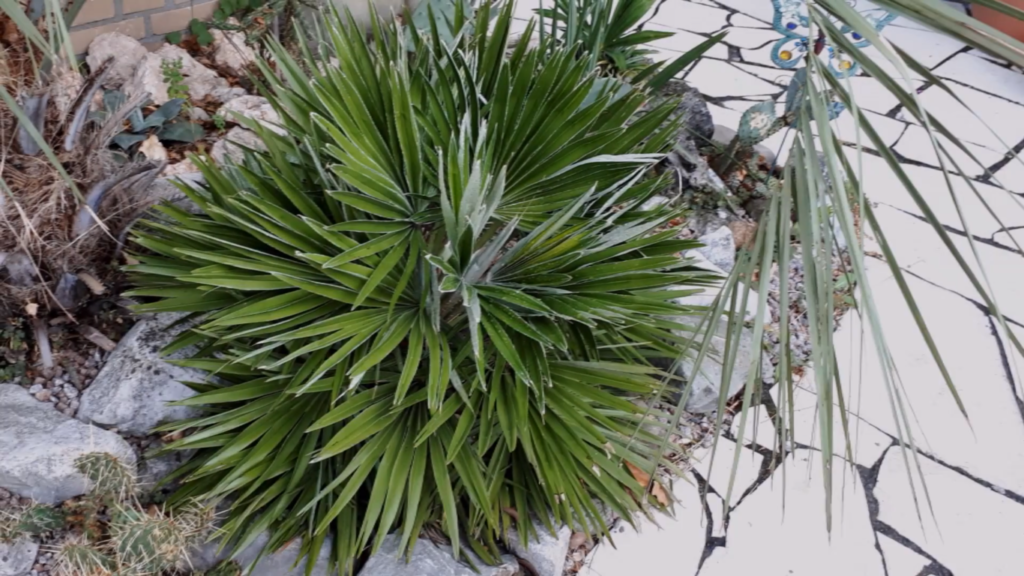
As such, they are not suitable for planting in areas that receive regular frost or snowfall throughout the year.
However, this doesn’t necessarily mean that palm trees are unable to survive in cooler climates. While a majority of these plants won’t survive sustained cold weather, some species of palms can tolerate temperatures as low as 25°F. [1], [2], [3]
Palm Trees That Can Survive Cold Weather
The ability for certain palm trees to thrive in colder climates depends on two primary factors: the type of palm tree and the winter temperatures it is exposed to. The hardiness zone that a particular species of palm tree is suitable for will vary depending on which variety you choose. And there are plenty of varieties that can live through cold temperatures, even in climates that experience frequent frost. In this section, we will discuss some of the most cold-tolerant palm trees that can be grown in cooler climates.
Lady Palm
Lady palm (Rhapis excelsa) is a type of fan palm from the Arecaceae family. It’s native to southern China and Taiwan, but it has been cultivated in many other parts of the world for centuries. The Lady palm grows in clumps that can reach up to 10 feet tall and wide, with slender stems topped by graceful dark green fronds. Lady palms are very popular indoor plants as they adapt well to container culture and require minimal care. They are also tolerant to lower light levels and low humidity, making them an ideal choice for homes or offices with limited space.
Despite its tropical heritage, the Lady palm is surprisingly hardy and can tolerate temperatures down to 18-20°F. This makes the Lady palm an ideal choice for colder climates or those with a short growing season.
Puerto Rican Thatch Palm
The Puerto Rican Thatch Palm (Coccothrinax alta) is a species of palm native to Puerto Rico. It is one of the few palms that are able to survive in cold weather due to its hardiness. This palm can tolerate temperatures as low as 28°F. The Puerto Rican Thatch Palm grows slowly, reaching up to 25 feet tall and has fan-shaped leaves that look like a skirt on the trunk.
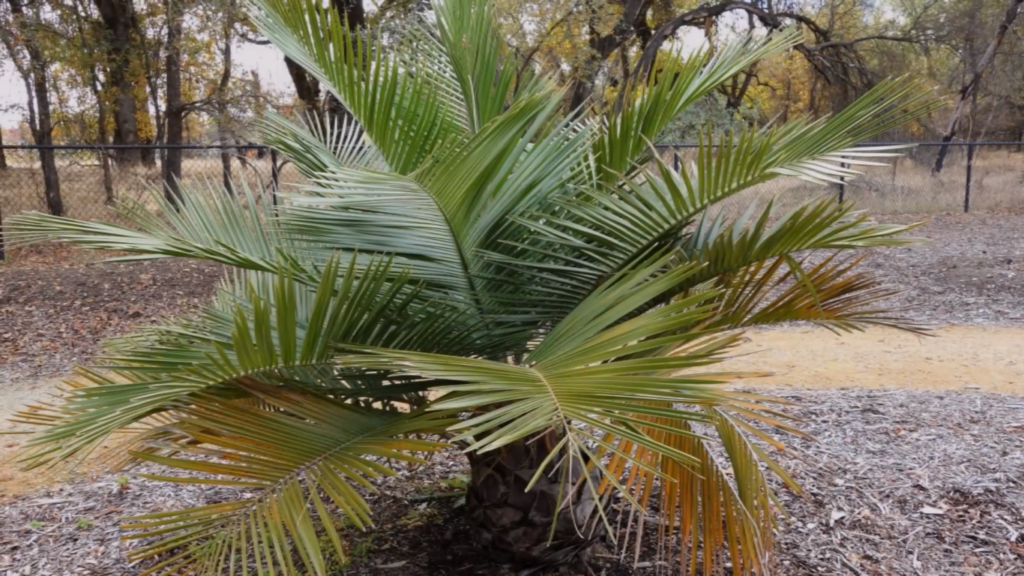
The Puerto Rican Thatch Palm is also known for being drought tolerant and able to thrive in full sun or partial shade. The palm also is resistant to salty soils and can survive in areas with high winds. It is often used as a landscaping tree or for screening purposes.
Date Palm
The date palm (Phoenix dactylifera) is a species of flowering plant in the Arecaceae family. It is native to the Middle East and North Africa, but it has been introduced to other parts of the world as an ornamental tree or for its edible fruit. Date palms can reach heights up to 80 feet, with trunks that are covered by a crown of large pinnate leaves. The fruits of the date palm are known as dates. These are typically eaten fresh, dried, or made into syrup or jams.
Date palms prefer dry climates with long periods of sunshine during their growing season. They also require well-drained soils and temperatures down to 15°F. As such, they are not ideally suited to regions with cold winters or excessive rainfall.
Queen Palm
Queen palm (Syagrus romanzoffiana) is a type of palm tree that is popular for its tropical beauty and resilience. The Queen Palm is native to Brazil, Argentina, and Paraguay and can reach heights of up to 50 feet. It has a single trunk with large dark green fronds and grows best in full sun or partial shade. The Queen Palm prefers well-drained soil or growing mediums like gravel, sand, and potting soil with good drainage.
Therefore it’s possible for a Queen Palm to survive in cold climates, provided the tree is properly cared for.
Everglades Palm
The Everglades Palm (Acoelorrhaphe wrightii) is a species of fan palm native to the everglades region of south Florida. It has long thin fronds which can reach up to 20 feet in height, and it produces small yellow flowers which turn into white or black fruits. The Everglades Palm is an incredibly hardy species, able to survive in wetland and saltwater conditions.
The Everglades Palm can survive in temperatures as low as 20°F for short periods of time. However, it is not recommended to try and overwinter the tree outdoors in climates where temperatures can dip below that value. The palm will suffer damage if left outdoors during prolonged cold weather, and may even die. Instead, it is best to bring the Everglades Palm indoors during winter months or grow it in a container that can be moved indoors as needed.
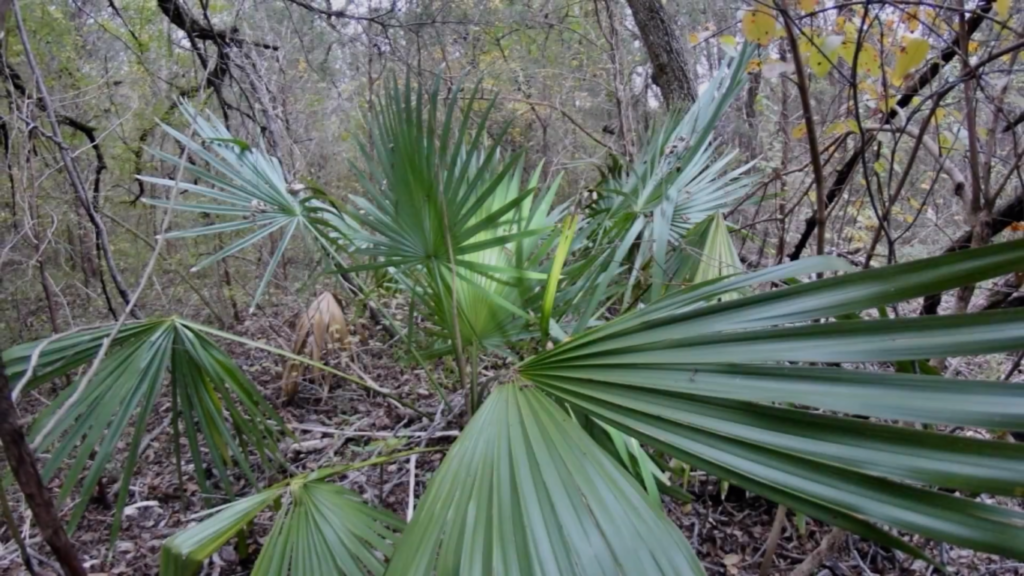
California Fan Palm
The California Fan Palm, also known as the Washingtonia Filifera, is a species of palm native to the southwestern United States and northern Mexico. It can grow up to 65 feet tall and has large fan-shaped leaves. The California Fan Palm is one of the hardiest palm trees available and can withstand temperatures down to 15°F. This makes it an ideal choice for colder climates where other types of palms may not survive.
In addition to its cold tolerance, this species of palm tree is also drought tolerant and prefers a sunny location with regular waterings during hot summer months. While it does not require much maintenance, the California Fan Palm benefits from pruning in order to keep its shape, as well as the occasional application of fertilizer.
Pindo Palm Tree
The Pindo palm tree, also known as the jelly palm tree (Butia capitata), is a species of palm tree native to South America. It is a hardy and versatile plant that can grow in tropical or semi-tropical climates, and it has an attractive appearance with feathery fronds and yellow-orange fruit. The Pindo palm is one of the most popular palms for landscaping in warm regions, but due to its cold tolerance, it can also be grown in areas with cooler temperatures.
Pindo palms typically have a single trunk that reaches 15 to 20 feet tall and sometimes taller. The leaves are fan shaped and usually stay green year round even in colder climates. The fruit of the Pindo palm is yellow-orange and has a sweet, jelly-like texture. The fruit can be eaten fresh or used to make preserves and jams.
The Pindo palm tree can handle temps down to about -5°F as long as it is planted in a sheltered spot and shielded from cold winds. This is by far one of the most cold-resistant palm trees available and it is one of the few palms that can survive in colder regions. In order for a Pindo palm to flourish, however, it needs plenty of sunlight and well-draining soil. Additionally, the roots should be mulched in order to protect them from cold temperatures.
Cabbage Palm
Cabbage palm, scientifically known as Sabal palmetto, is one of the most common palms found in the Southeast United States. It is a hardy species that is uniquely adapted to tolerate cold temperatures and can be grown in USDA plant hardiness zones 8b through 11. These palms are recognizable by their fan-shaped fronds and tall trunks topped with a tuft of spiny leaves. This palm is hardier than others and can handle down to 15°F.
The cabbage palm gets its name from its edible terminal bud which can be boiled or steamed and eaten like cabbage. The fruit of this palm tree is also edible, often used to make jelly or wine. Cabbage palm trees can reach heights up to 50 feet but are typically much smaller when planted.
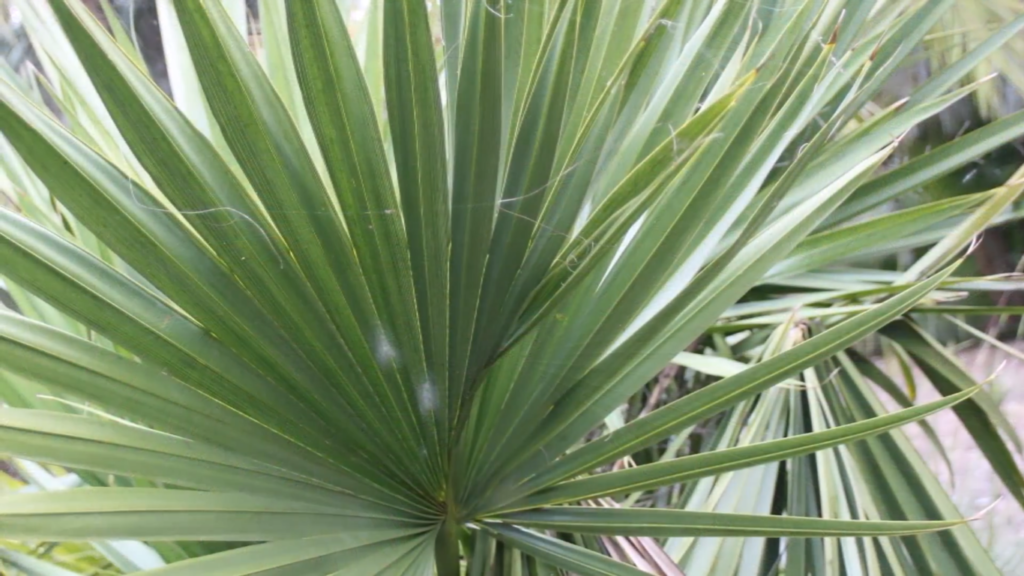
Chinese Fan Palm
The Chinese Fan Palm, also known as the Livistona chinensis, is a species of palm tree native to eastern and central China. It is an evergreen plant that can grow up to 30 feet tall with fan-shaped fronds up to five feet in length. Its thick trunk is ringed at the base, giving it an attractive appearance even without its leaves.
The Chinese Fan Palm is widely used in landscaping due to its elegant look and hardiness in many different climates. In some regions it can tolerate temperatures down to 20°F for brief periods. The palm prefers well-draining soil and full sun or partial shade, making it easy to maintain in a variety of conditions. This makes it a popular choice for gardeners looking to bring a tropical feel to their outdoor space.
The Chinese Fan Palm is also relatively disease and pest resistant, meaning that it won’t require frequent maintenance or treatments. However, too much cold can still be damaging – so consider this before planting your tree in a colder climate!
European Fan Palm
The European Fan Palm (Chamaerops humilis) is a species of palm tree native to Europe, North Africa and the Canary Islands. This species of palm is one of the hardiest palms in existence, surviving temperatures as low as 5°F. It is also able to tolerate short-term cold spells such as frost or snow due to its extensive root system which extends deep into the surrounding soil.
The leaves of this palm are fan-shaped with serrated edges and are green in color. It prefers full sun exposure but can tolerate partial shade if necessary. It is slow to grow but can reach heights of up to 15 feet in ideal conditions. The European Fan Palm can also be grown as a potted plant, making it an excellent choice for colder climates where temperatures drop below freezing.
Saw palmetto
Saw palmetto (Serenoa repens) is a low-growing fan palm native to the southeastern United States, primarily in the coastal regions of Florida. It grows up to 6 feet tall and can survive temperatures as low as 0°F. Saw palmetto is one of the most cold-resistant palms available and is often used in landscaping as an ornamental tree.
The plant got its name from its saw-like leaves, which are green on top and silvery underneath. Saw palmetto produces small dark purple fruit in the summer months that can be used to make jams and jellies. It is also a popular ingredient in herbal medicine for treating certain health issues such as enlarged prostate, urinary tract infections, and hair loss.
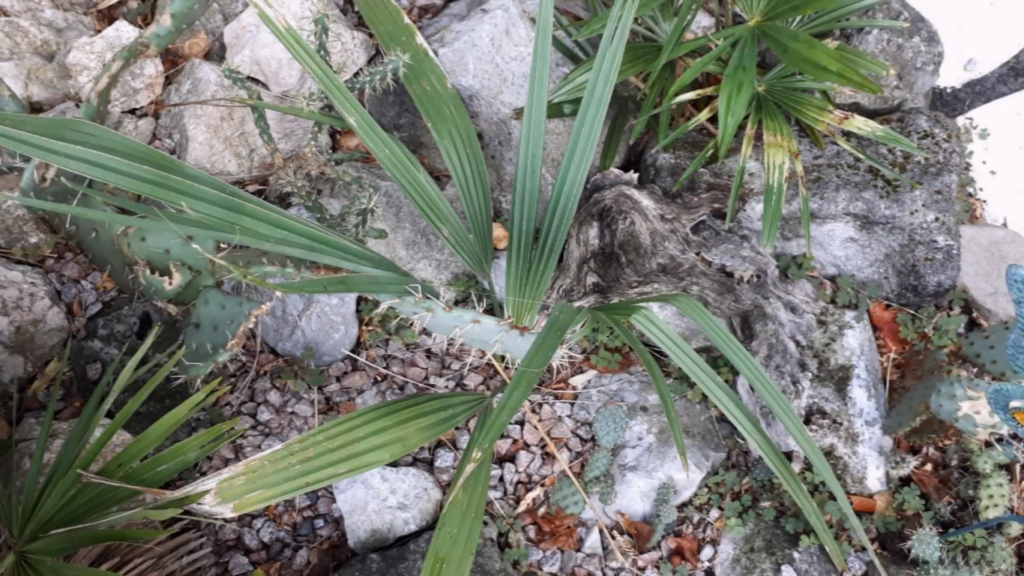
Mexican Fan Palm
The Mexican Fan Palm is often used as an ornamental landscaping accent or specimen tree in temperate climates because it tolerates cold weather better than most other palms.
This palm, as the most other palms on this list, can tolerate the temps of down to 20 degrees Fahrenheit.
Bismark Palm
The Bismarck palm (Bismarckia nobilis) is a large and distinctive fan palm native to the island of Madagascar. It’s one of the few palms that can survive in cold climates, making it an excellent choice for tropical-style landscaping in temperate regions. Bismarck palm can withstand temperatures as low as 15°F, making it one of the hardest palms available.
The Bismarck palm has long, segmented leaves and is typically grown in a single trunk or clump form and can grow to a maximum height of about 70 feet.
Still, it shouldn’t be exposed to too much cold weather. To prevent damage from cold weather, it’s advisable to provide some frost protection for the tree in regions where the temperature drops below 25°F. Covering with a tarp or blanket is a simple and effective way to trap heat around the trunk of the palm and help protect it against freezing temperatures.
Mexican Blue Palm
Mexican Blue Palm (Brahea armata) is a slow-growing palm tree native to the dry regions of Mexico and the southwest United States. The Mexican Blue Palm grows at a moderate rate and can reach heights of up to 50 feet. This type of palm tree features thick, costapalmate blue/green fan shaped leaves that grow directly from the trunk in a circular pattern. The trunk itself can reach diameters of 6 inches or more and has a distinct silvery-gray color with distinctive old leaf bases still clinging to it.
The Mexican Blue Palm thrives in zones 9 – 11, making it one of the hardiest palms available for colder climates. It can tolerate short periods of temperatures down to 18 degrees Fahrenheit, and is often planted near patios or pool areas for its ornamental value. The Mexican Blue Palm absolutely doesn’t like humidity, so it’s best to plant it in an area that gets good air flow and full sun for optimal growth.
Canary Island Date Palm
Canary Island Date Palm (Phoenix canariensis) is a species of palm tree native to the Canary Islands, off the west coast of North Africa. It is a beautiful and very popular ornamental plant, characterized by its robust trunk and dense canopy of large pinnate leaves. The fronds may reach up to 60 feet in height.
The Canary Island date palm has a wide range of adaptations that enable it to survive better than other palms in cold weather conditions. It can handle temperatures as low as 15°F and can be found growing in various parts of the United States, including California, Arizona and Florida.
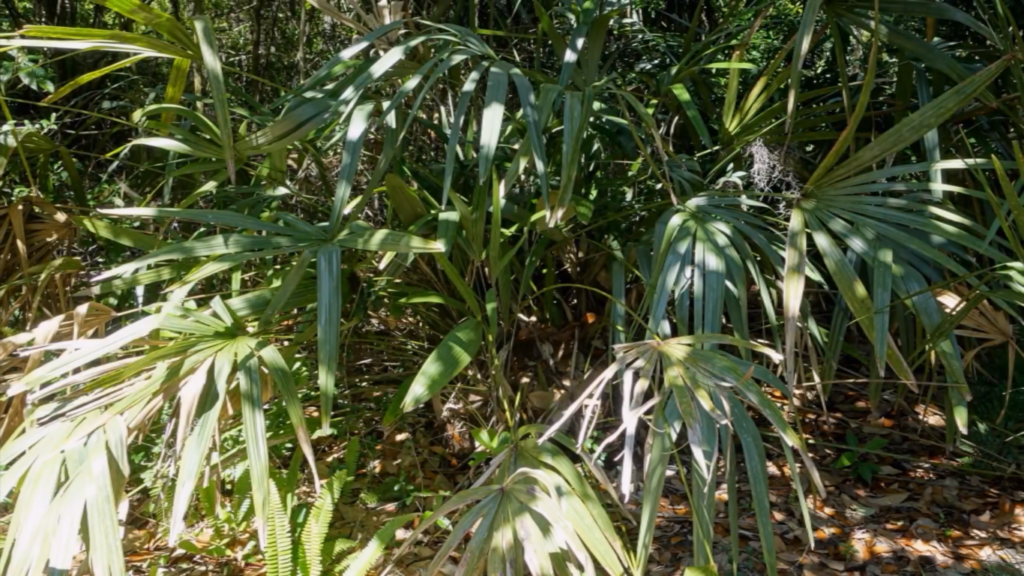
It’s worth mentioning that Canary Island date palm isn’t a self-cleaning species, meaning it will not shed its dead fronds. As such, regular maintenance is required to keep the tree healthy and free of rotting debris that can attract pest infestations or cause damage to the trunk and roots over time. [1], [2], [3], [4]
Tips for Growing Cold Hardy Palms
While choosing a cold-hardy palm tree for your yard ensures that it can survive in colder climates, there are a few extra steps you can take to ensure that your palm is well-equipped to handle winter’s chill.
Use a cover for smaller trees
For smaller palm trees, protect them from the elements with a cover or a wrap. This will help to keep their temperatures more consistent and block wind gusts that can cause damage. Make sure you use breathable materials like burlap or cotton so your palms don’t become too hot in the sun.
Fertilize the trees regularly
Fertilizing your palm tree on a regular basis helps build up its energy reserves and assists the plant in recovering from cold stress. Fertilize with a balanced fertilizer once or twice a year, depending upon the species of palm you have chosen. If your palms are exposed to extreme cold temperatures, consider adding an extra dose of fertilizer just prior to the onset of winter.
Apply anti-freeze spray
Using a specially formulated anti-freeze spray can help protect your palm tree from the cold. Anti-freeze sprays are designed to coat plants with a layer of protection that helps prevent freezing temperatures from damaging delicate parts of the plant. Be sure to apply the spray before winter arrives, as it is only effective when applied before cold temperatures set in.
Apply mulch
Mulch is essential for protecting a palm tree’s root system during winter. A thick layer of mulch applied around the base of the tree will help to preserve moisture and regulate soil temperatures, both of which are essential for cold-hardy palms. [1]
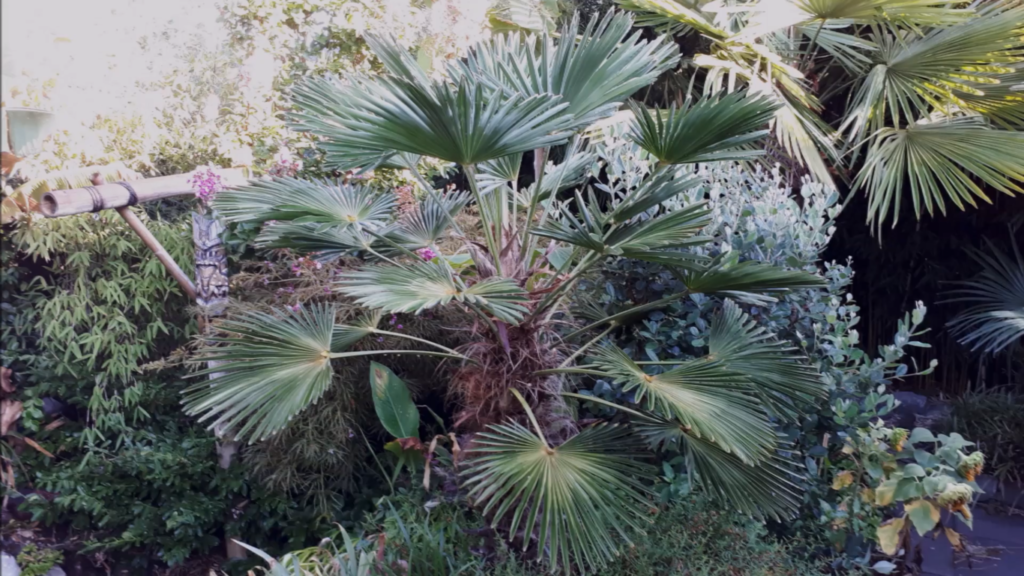
FAQ
What is the lowest temperature palm trees can survive?
The lowest temperature a palm tree can survive for a prolonged period is around 5 degrees Fahrenheit, although this is rather an exception from the norm. This temperature can be fatal for some species, while others may just suffer from leaf damage or a light foliage.
Certain other species can tolerate temps below 0 degrees Fahrenheit. However keep in mind this is only for a short period of time and such species are few and far between.
To ensure that your palm tree is able to survive cold temperatures, it’s worth taking the time to research what type of palm tree you have. This will help you determine whether or not it can withstand cold weather.
What is the most cold tolerant palm?
The most cold-tolerant palm is the Trachycarpus Fortunei, also known as the Chinese Windmill Palm. The Trachycarpus is native to central and eastern Asia, where it can withstand temperatures as low as -10 degrees Fahrenheit. It has deep green fan-shaped fronds and a trunk that can reach up to 45 feet tall in the wild.
In temperate climates, the Trachycarpus is hardy enough to survive outside year-round with some protection from wind and frost. While it won’t thrive in freezing conditions, it will still tolerate occasional light frosts and snowfall without damage.
What temperature can the palm tolerate?
The most cold-tolerant palm trees can survive in temperatures down to about 15°-20°F, with some species even able to withstand occasional dips below 0°F. The upper limit for the majority of palm tree species is about 112°F, with certain tropical varieties only surviving up to 85°F.
Can palms survive a freeze?
The answer to this question depends on the type of palm tree you are dealing with. Some cold hardy varieties can survive a freeze to temperatures as low as 20 degrees Fahrenheit, while other species such as the Chinese Fan Palm and Mexican Fan Palm are not able to handle such temperatures for too long.
When faced with a freeze, most palm trees will die back in some way – whether through leaf drop or complete death of fronds. If you live in an area where temperatures drop below freezing, it is important to select a type of palm tree that is well adapted for your climate so that it can withstand winter’s chill without any major damage.
Useful Video: Top 10 Palms that will survive without winter protection
Conclusion
Palm trees are typically associated with warmer climates, so the question of whether they can survive in cold weather has a complex answer. Though there are certain palm species that are hardy enough to endure low temperatures, most palms cannot tolerate freezing conditions and need protection from frost.
Still, it is possible to grow a palm tree in colder climates if it is given proper protection and care. Start by selecting a hardy variety from our list, and then make sure to have a plan in place for protecting it from cold weather. For example, you can use frost cloth or mulch during winter months to insulate the roots, and bring young trees inside or place them in sheltered areas when temperatures begin to drop.
By taking the necessary precautions, you can enjoy having a beautiful palm tree in your garden even if you don’t live in a warm climate! With the right variety of palm and regular care and attention, your tropical oasis will be thriving no matter where you are.
With these precautions in place, and with proper maintenance, there’s no reason why you can’t enjoy having a beautiful palm tree in your landscape even when temperatures dip below freezing!
References
- https://www.thespruce.com/types-of-palm-trees-2132854
- https://www.masterclass.com/articles/cold-hardy-palm-trees-guide
- https://www.gardengatemagazine.com/review/can-palm-trees-survive-in-non-tropical-climates/
- https://www.plantingtree.com/products/pindo-palm






Leave a Reply